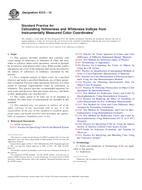We need your consent to use the individual data so that you can see information about your interests, among other things. Click "OK" to give your consent.
ASTM E313-10
Standard Practice for Calculating Yellowness and Whiteness Indices from Instrumentally Measured Color Coordinates
STANDARD published on 1.7.2010
The information about the standard:
Designation standards: ASTM E313-10
Note: WITHDRAWN
Publication date standards: 1.7.2010
SKU: NS-46377
The number of pages: 6
Approximate weight : 18 g (0.04 lbs)
Country: American technical standard
Category: Technical standards ASTM
Annotation of standard text ASTM E313-10 :
Keywords:
color, colorimetric analysis, color/light, instrumental measurement, reflectance, reflectivity, whiteness indexes, yellowness indexes, Ceramic materials/applications, Color, Color--opaque materials, Colorimetric analysis, Instrumental measurement--color/light, Latex paints, Opacity/opaque materials, Paint testing, Paper, Psychophysical examination, Reflectance and reflectivity--paints/related coatings/materials, Solventborne paints/coatings, Spectral data--paints/related coatings
Additional information
| Significance and Use | ||||||||||||||||||||||||||||||||||
|
This practice should be used only to compare specimens of the same material and same general appearance. For example, a series of specimens to be compared should have generally similar gloss, texture, and (if not opaque) thickness, and translucency. For yellowness measurement, this practice is limited to specimens having dominant wavelength in the range 570 to 580 nm, or Munsell hue approximately 2.5GY to 2.5 Y. For whiteness measurement, this practice is limited to specimens having Munsell value greater than 8.3 (CIE Y greater than 65) and Munsell chroma no greater than 0.5 for B hues, 0.8 for Y hues, and 0.3 for all other hues (see 3.3.1). The combination of measurement and calculation leading to indices of yellowness or whiteness is a psychophysical process, that is, the procedures specified are designed to provide numbers correlating with visual estimates made under specified typical observing conditions. Because visual observing conditions can vary widely, users should compare calculated indices with visual estimates to ensure applicability. Some standards addressing the visual estimation of color and color difference are Practices D1535, D1729, E1360, and E1541, and Guide E1499. This practice does not cover the preparation of specimens, a procedure that may affect significantly the quantities measured. In general, specimens should be prepared and presented for measurement in the manner that is standard for the test being performed. Select enough specimens or specimen areas to provide an average result that is representative of each sample to be tested. See Practice E1345. |
||||||||||||||||||||||||||||||||||
| 1. Scope | ||||||||||||||||||||||||||||||||||
|
1.1 This practice provides numbers that correlate with visual ratings of yellowness or whiteness of white and near-white or colorless object-color specimens, viewed in daylight by an observer with normal color vision. White textiles, paints, and plastics are a few of the materials that can be described by the indices of yellowness or whiteness calculated by this practice. 1.2 For a complete analysis of object colors, by a specified observer and under a specified illuminant, use of three parameters is required. For near-white specimens, however, it is often useful to calculate single-number scales of yellowness or whiteness. This practice provides recommended equations for such scales and discusses their derivations and uses, and limits to their applicability (see also Ref (1) ). 1.3 The values stated in SI units are to be regarded as standard. No other units of measurement are included in this standard. 1.4 This standard does not purport to address all of the safety concerns, if any, associated with its use. It is the responsibility of the user of this standard to establish appropriate safety and health practices and determine the applicability of regulatory limitations prior to use. |
||||||||||||||||||||||||||||||||||
| 2. Referenced Documents | ||||||||||||||||||||||||||||||||||
|
We recommend:
Updating of laws
Do you want to be sure about the validity of used regulations?
We offer you a solution so that you could use valid and updated legislative regulations.
Would you like to get more information? Look at this page.




 Cookies
Cookies
